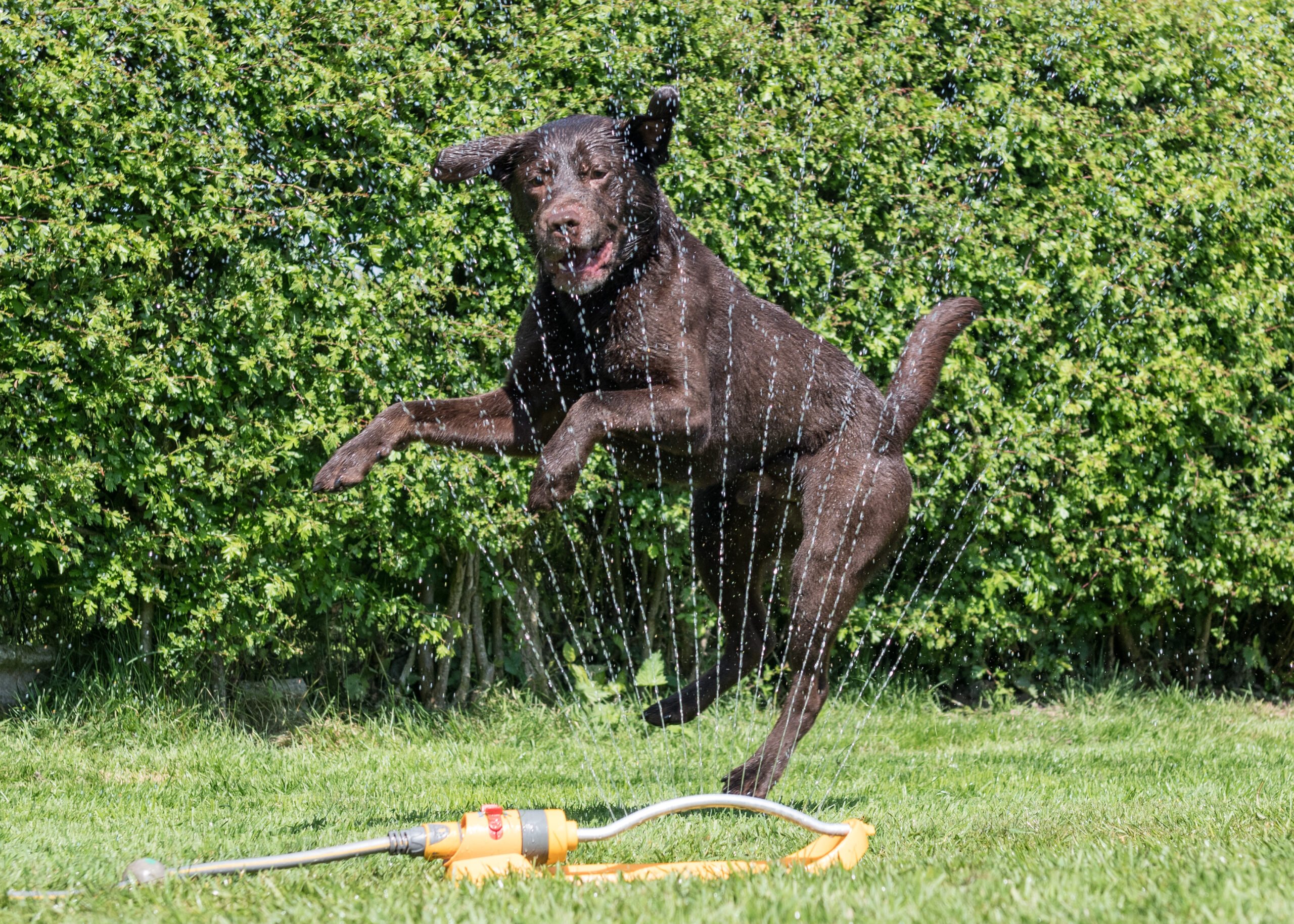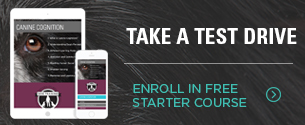By encouraging your clients to create a safe, engaging and fun space in their own yard, their dogs can enjoy appropriate outlets–and be less likely to cause mayhem.

As a dog trainer, you know how important it is for dogs to have enriching experiences in and around their home–preferably not by wrestling with couch pillows, digging in the vegetable garden, or sneaking out of the yard on an adventure.
Outdoor enrichment features can stimulate a dog’s senses, provide mental and physical stimulation, and allow them to exercise their natural behaviors. Let’s explore ideas you can share with your clients so they can avoid potential outdoor hazards while adding canine enrichment features to their outside space.
Agility Equipment
Agility equipment is a great way to provide physical and mental stimulation for dogs. It can include jumps, tunnels, weave poles, and more. Dogs love to run, jump, and climb, and agility equipment provides a safe and fun way for them to do so. Encourage your clients to start with simple equipment and progress to more advanced equipment as their dog becomes more confident and skilled.
They might even experiment with a DIY agility course arranged with simple items they have at home, such as laundry baskets and broom handles.
Pro Tip: When introducing agility equipment, it’s essential to start with basic equipment and supervise the dog closely. If the dog has never used agility equipment before, it may take some time for them to learn and become comfortable. Also, be aware of the dog’s physical abilities and avoid equipment that could cause injury. It’s important to provide proper training and supervision to ensure the dog’s safety.
Digging Pit
A digging pit provides a safe and fun area for dogs to engage in their natural behavior of digging. Typically designed like a large sandbox for children, it can prevent dogs from digging up unwanted areas in the yard, such as gardens or flower beds. Additionally, hiding toys or treats in the digging pit gives an added incentive plus mental stimulation for the dog.
Pro Tip: When creating a digging pit, it’s important to make sure that it’s in a safe area and away from any potential hazards. Remind clients to monitor their dog closely, so that digging is only inside the designated area, and to offer the dog praise for a job well done!
Sensory Gardens
A sensory garden is an excellent way to provide a stimulating environment for dogs. It’s a garden that’s designed to engage a dog’s senses, such as smell, sight, touch, and taste. Dogs will love exploring the different textures, scents, and tastes in the garden. A sensory garden can be created using a variety of plants, such as herbs, flowers, and grasses. Encourage your clients to include plants that are safe for dogs to eat, such as mint, curly parsley (and only curly parsley – others are toxic to dogs!), and rosemary. They can also consider including different types of mulch, rocks, and water features to provide more sensory experiences for their dog.
Caution! For dogs that tend to chew or swallow foreign objects, garden features such as mulch and small rocks should be avoided. Also, caution them about choosing chemically treated wood decking or yard treatments that can be absorbed through paws.
Pro Tip: When creating a sensory garden, choose plants and materials that are safe for dogs. Some plants can be toxic and cause harm if ingested, so it’s essential to research and confirm the safety of the plants before adding them to the garden. The ASPCA has a great list of toxic and non-toxic plants you can share with your clients. Also, be aware that some dogs may have allergies to certain plants or materials, so it’s important to monitor their reactions closely.
A Water Feature
Some dogs love playing in water. A water feature like a baby pool or a yard sprinkler provides them with an interactive way to cool off during hot weather. Adding toys in or near the water feature can make it even more enticing to dogs.
Some clients are lucky enough to have a natural waterway on their property, like a creek, pond, or water-filled ditch. However, with natural water comes extra pet safety responsibilities. Clients should check for hazards like steep edges, sharp rocks, stagnant water, or unseen chemical contamination. Encourage them to talk to their veterinarian about whether a leptospirosis vaccination might be a good idea to help protect from this wildlife-borne illness that dogs can pick up from soil and water. Also give them a heads-up about how to prevent exposure to life-threatening toxic blue-green algae in lakes, ponds, and rivers during hot weather.
Pro Tip: Clients will need to replace water in unfiltered artificial pools frequently to keep it clean and hazard free. Don’t leave old water standing for days, as it can attract mosquitos and other pests. Open pools also invite wildlife to visit for a sip of water, sometimes resulting in face-to-face conflicts or contamination of the water with disease-carrying feces. No one wants to turn what’s intended to be a fun feature for dogs into a hazard!
Room to run! Dog-friendly Play Areas
Dogs love to play, and having a designated play area in the yard is a great way to encourage exercise. The play area should be safe and secure, and include toys and other play equipment. Encourage your clients to rotate the toys to keep their dog engaged and interested. Some people include sturdy landscaping items, like broad rocks, that can be climbed easily and explored.
Pro Tip: It’s important to ensure that a play area is safe and secure. The area should be securely fenced and free from potential hazards such as toxic plants or sharp objects. Also, monitor the dog’s behavior during play and supervise closely to prevent any injuries or conflicts with other dogs or animals. Pets should never be left unattended, even in a fenced yard. It’s far too easy for wildlife to climb or leap over, or for a visitor to leave a gate ajar.
Your enrichment ideas are a great resource for your clients
You can share your ideas in a printable flyer your clients can take home, on a dedicated page on your website, or in an infographic on social media. Check out these ways you can get your ideas in the hands or in front of the eyes of your clients and your community.
Share your creative outdoor canine enrichment ideas with us!
How have your clients incorporated fun enrichment into the back yard? Do you have any fun ideas to share? Visit the Victoria Stilwell Academy on Facebook and let us know.



